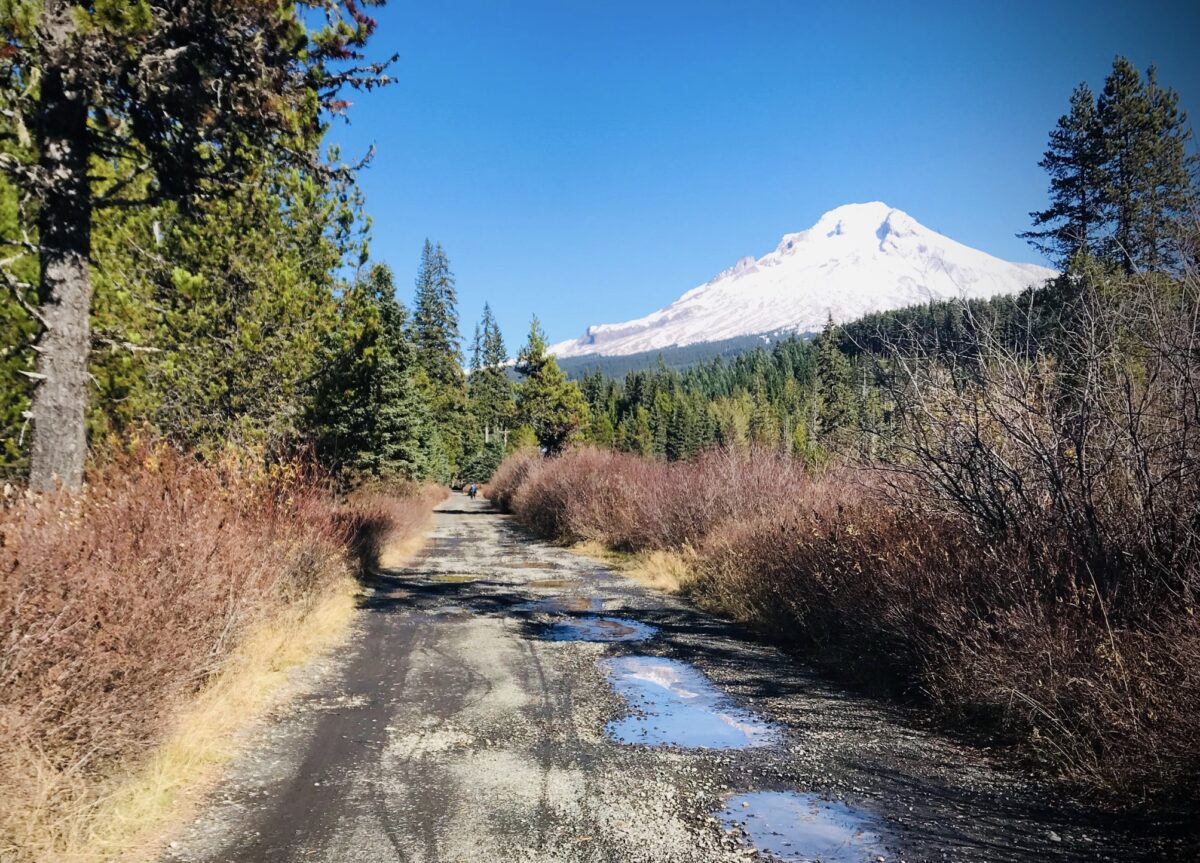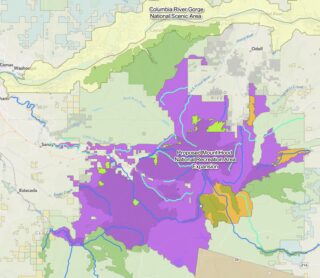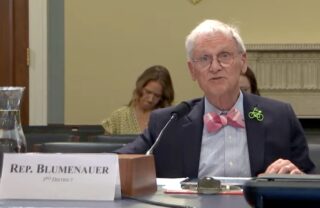
(Photo: Jonathan Maus/BikePortland)
Congressman Earl Blumenauer, the former Portland city commissioner who founded the Congressional Bike Caucus, is mostly known for his work on urban bike infrastructure and commuting. Now his iconic bike pins might need to be retrofitted with knobby tires.
“A huge win for mountain biking.”
— Nate Kuder, Oregon Mountain Biking Coalition
On Monday, Blumenauer introduced the Mt. Hood and Columbia River Gorge Recreation Enhancement and Conservation (REC) Act (H.R. 7665). At a hearing for the bill Wednesday at the Committee on Natural Resources Subcommittee on National Parks, Forests, and Public Lands, Blumenauer said these iconic areas are “being loved to death.” “There are over eight million people within a four hour drive. The pandemic has put a great deal of stress on them,” he said.
Blumenauer’s bill does three main things: It vastly increase the acreage of land surrounding Mt. Hood designated as National Recreation Area to 350,000 acres, making it the sixth largest in the nation; it creates a first-ever co-management plan with Confederated Tribes of the Warm Springs (to “improve their ability to exercise treaty rights” after “167 years of broken promises,” Blumenauer says); and it requires a sustainable recreation management plan for the Columbia River Gorge National Scenic Area.
The bill also includes $17.5 million in recreation planning so it’s far from an unfunded mandate.
Advertisement

The nonprofit Oregon Mountain Biking Coalition (OMBC) lobbied hard for the bill and is in full support of it because the Recreation Area designation and the limited expansion of Wilderness Area (just 7,500 acres) means no existing mountain bike trails were lost. “The way this bill is specifically written to address non-motorized recreation and mountain biking in particular, really benefits us greatly,” said OMBC Board Chair Nate Kuder in an interview yesterday. “It requires the Forest Service to prioritize non-motorized outdoor recreation in their forest plan.”
Kuder also said much of the land around Mt. Hood have already been logged and/or are in need of major fire suppression projects. But once land is designated wilderness, the Forest Service can’t use power tools to clear overgrowth. Given the rise of massive wildfires, that’s probably a big reason Blumenauer added just 7,500 new acres of it.

It’s a decision that has led to opposition of this bill by Oregon Wild, a nonprofit that wanted Blumenauer to add 178,000 new acres of wilderness. In a statement, Oregon Wild said they are concerned the lack of wilderness acreage will lead to more logging and won’t lead to enough protection. But many other environmental groups support the bill, including: Bark, American Whitewater, Outdoor Alliance, Pacific Crest Trail Association, Sustainable Northwest and other.
Advertisement
Another way a larger recreation overlay will impact cycling has to do with fire-related road and trail closures. When fires rip through wilderness areas, public access is closed for a long time because of legal limitations about human and machine interventions in wilderness areas. With a more recreation-centric planning approach, forest lands will reopen much sooner after fire damage.
The new Recreation Area designation will also unlock millions of federal dollars for future trail and trailhead projects. With the pandemic boom in outdoor recreation, much of the federal funding to support it are only available to areas with the National Recreation Area designation. “Having access to additional funding to build trails, to build infrastructure, trailheads and parking lots and things like that, is a huge win for mountain biking,” Kuder said.
Kuder is also a volunteer with 44 Trails Association. He says currently only one-third of the land they help maintain is in a Recreation zone. If this bill passes, all of it will be. He says the bill guarantees more bike trails in the future.
On the Columbia River side, the bill will also hasten the move toward fewer cars in the Gorge. There’s been a movement toward reducing car trips in the Gorge spearheaded by ODOT and transit providers (one of whom, Columbia Area Transit, supports the bill). But their progress has been limited in part by complex overlapping jurisdictions and more conservative partners like the US Forest Service. The REC Act requires a sustainable recreation management plan for the Columbia River Gorge National Scenic Area, “with considerations for socially, economically, and ecologically sustainable recreation, recreation planning, and recreation infrastructure.”
The bill also calls for the creation of two Access Committees, one for the Gorge and one for Mt. Hood, that will create plans for more “ecologically sustainable access” and to, “prioritize reliable and user-friendly transportation and transit options.”
Learn more about the bill and find the online comment portal here.

